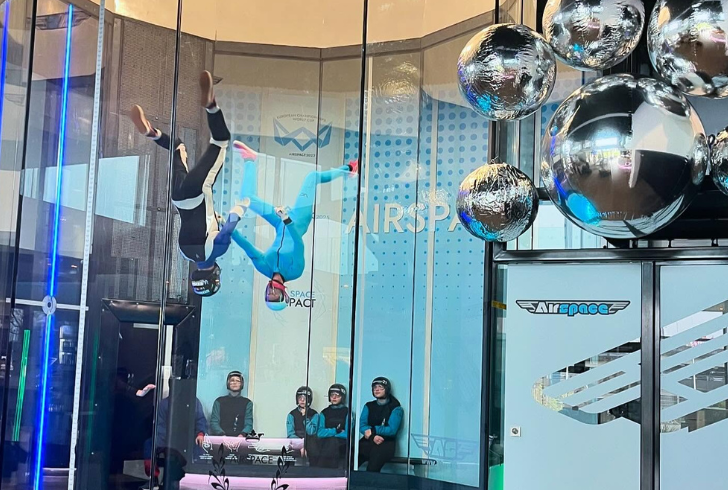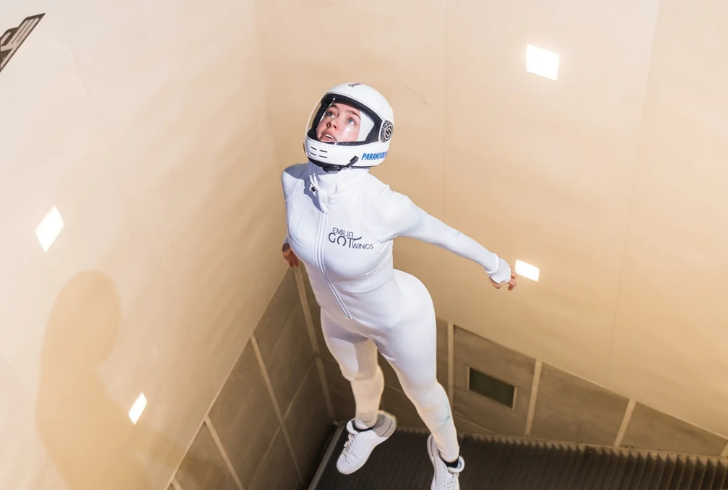Indoor skydiving isn’t just a fun experience for thrill-seekers—it’s now a recognized global sport, where athletes defy gravity in vertical wind tunnels with jaw-dropping acrobatics. This high-energy competition blends skill, artistry, and pure physics, offering spectators an unforgettable view of what the human body can do when lifted by nothing but air.
At the heart of this growing scene is the World Indoor Skydiving Championships, an international event that's redefining aerial sports one spin at a time.
The Rise of a Sport That Floats on Air
Held in Charleroi, Belgium, the 5th World Indoor Skydiving Championships brought together top-tier athletes from across continents to compete in both group and solo categories. Organized by the Fédération Aéronautique Internationale (FAI), the event has become a major fixture in the indoor skydiving calendar. And it’s easy to see why.

Instagram | airspaceindoorskydiving | Charleroi hosted the 5th World Indoor Skydiving Championships for global group and solo athletes.
Performers twist, flip, and glide with precision in giant transparent wind tunnels, creating an experience that’s a mix of freestyle gymnastics and synchronized dance, just suspended mid-air. The action is mesmerizing. Even if you're not in the room, the recorded footage from FAI allows fans everywhere to catch the show.
Where It All Started
While indoor skydiving might seem like a recent trend, its origins are surprisingly tied to aerospace research. Back in 1964, engineers at Ohio’s Wright-Patterson Air Force Base—working on NASA’s Apollo program—created the first vertical wind tunnel. Designed for testing, it eventually evolved into the recreational and competitive activity known today.
Fast forward to now, and there are over 200 wind tunnel facilities scattered across the globe. These aren't just training spots for professional skydivers—they’ve become venues for everyday adventurers and elite athletes alike. Most tunnels are made from transparent plastic or plexiglass, which not only boosts the visibility for spectators but turns each routine into a public performance.
Categories That Test Precision and Creativity
The World Championships divide events into two main styles: Indoor Formation Skydiving and Artistic Events.
1. Indoor Formation Skydiving:
- Teams of four perform coordinated formations.
- Each round lasts 35 seconds, during which teams complete as many maneuvers as possible.
- Points are awarded for each cleanly executed formation.
- Any misstep is labeled a “bust” and counts for zero points.
This category isn’t just about speed. Precision is everything. Teams must “hold” each shape perfectly before advancing to the next—sometimes reaching 30 successful holds in less than a minute.
2. Artistic Events:
This category highlights the true acrobatics of the sport. It includes:
Solo Freestyle - Athletes perform both required and freeform routines, often choreographed to music. The routines showcase rhythm, flexibility, and control.
Dynamic Rounds - Two- or four-person teams execute synchronized speed and freestyle segments. These performances are high-paced and visually stunning, demanding exact timing and seamless coordination.
As described by the FAI, every movement has to be technically precise. For example, in formation rounds, “Each team must complete the intended shape before progressing—any failure to do so means zero score on that move.”
Who Took the Top Honors?
This year’s champions reflected the rising level of skill and artistry within the sport.
In the Solo Freestyle category, Poland’s Maja Kuczyńska captivated the judges with a routine that combined graceful fluidity and precise control, delivering a standout performance that clearly set her apart.
Meanwhile, Team Singapore claimed the top spot in the Dynamic Four-Way event, impressing both judges and spectators with their seamless synchronization and fast-paced execution, securing their victory with a near-flawless display of teamwork and timing.
Why Indoor Skydiving Is Gaining Attention

Instagram | airspaceindoorskydiving | Indoor skydiving showcases human control and artistry within engineered airflow.
What makes this sport so compelling? It’s the raw display of human capability interacting with engineered airflow. These athletes aren’t just floating—they’re directing their bodies with incredible awareness and control in a space that allows for three-dimensional movement. Each routine feels like a performance and a physics experiment at the same time.
With its blend of competitive spirit, technical skill, and visual drama, indoor skydiving is carving out its own space in the world of acrobatic sports. And the numbers don’t lie—the growing number of tunnels and participating countries signals a strong future.
The Energy Behind Every Spin
The World Indoor Skydiving Championships isn’t just about competition—it’s about showcasing what’s possible when talent meets innovation. With more athletes pushing the limits of air-driven acrobatics and more fans tuning in worldwide, this airborne sport is building serious momentum.
As indoor skydiving continues to evolve, expect the routines to get even more creative, the performances more polished, and the acrobatics even more thrilling. Whether you're an adrenaline junkie or just someone fascinated by the limits of motion, this is a sport worth watching—because it quite literally lifts the game to new heights.
